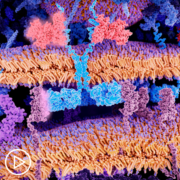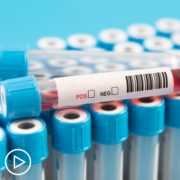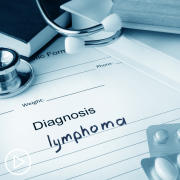Making Treatment Decisions | Understanding Common Myeloma Therapies
Making Treatment Decisions | Understanding Common Myeloma Therapies from Patient Empowerment Network on Vimeo.
What are common myeloma therapies, and when are they used? Dr. Ashley Rosko outlines the factors that impact treatment decisions and reviews available therapies including stem cell transplant, proteasome inhibitors, immunomodulatory therapies, and monoclonal antibodies.
Dr. Ashley Rosko is Medical Director of the Oncogeriatric Program at the Ohio State University Comprehensive Cancer Center – The James. Learn more about Dr. Rosko.
Related Programs:

|

Advances in Myeloma Treatment | CAR T-Cell Therapy and Bispecific Antibodies |
Transcript:
Katherine:
We know that multiple myeloma patients have a number of options and that many available therapies are used in combination.
So, I’d like you to walk us through the options that are available.
Dr. Rosko:
So, I’m going to start by how the best way that I can frame out when we talk about newly diagnosed versus patients when they have relapse. So, there are therapies that are available for patients that are FDA-approved when they are newly diagnosed with the cancer, and there are therapies that are approved only when a cancer has acted up again or relapsed.
So, I’ll kind of frame it from patients who are newly diagnosed. And then, I also will talk more about relapsed therapies and what we’re able to offer to patients. So, in first, when we talk about treatment options, we frame treatment based on a couple things. So, one is, we talk extensively about the disease biology. So, that plays an important role in how we decide which treatment the patient should get.
And then, the second part about how – I would probably say there’s about four main parts. And so, disease biology is one, and another thing has to do with the patient characteristics. In terms of the patient’s overall health prior to developing cancer, and also how the cancer has impacted their health in terms of everyday activities. Whether or not a person has really slowed down quickly, whether they’ve been in the hospital, and how it’s impacting their organs. Because that plays a role in terms of what we’re able to give patients.
If a patient has advanced kidney failure, which can sometimes happen, or if you have to focus more on protecting their bones and if there’s concern about fractures and things like that. And then independent of patient characteristics in terms of overall health, the last part I talk to patients about is their own preferences. It’s a hard thing to talk about, shared decision-making in a cancer that most people have never heard about, but there is certainly – when we talk about options and there are, it’s important to talk about shared decision-making in terms of what’s most important to them and where they – and most patients will say, “Well, I just want the best medicine.”
And I say to them, “Well, you know, we have lots of options, and that’s the best thing about it, but we also want to be cognizant of the real world, of giving best options,” and for example, Many of my patients – so, I’m at The Ohio State University, I’m here. And a lot of patients travel. I have a lot of older patients that I care for, and they’re very independent with travel. And I want to make sure that whatever therapies we’re getting for them, that we can do this in such a way that maintains their lifestyle.
So, the beginning part of a treatment, it is broadly described as – when we talk about someone who was diagnosed with this, it’s this thing called induction. So, induction is when we give anywhere from two to four medications to be able to control their cancer and put it into remission. And we know that the cancer is in remission because, like we started out the conversation with Dr. Cottini, myeloma makes proteins. Oftentimes, it makes proteins, those proteins are not nutrition proteins but are cancer proteins that we can track in the blood.
So, we can check them every month and to make sure that the patients are having a really good response, and as such, we’re able to define that they’re responding to their treatment. Because they have a beginning stage in induction, which they’re given treatment, and then the goal is to put patients put in remission.
Depending on the overall health of the patient, a standard of care for most patients diagnosed with multiple myeloma is to undergo an autologous stem cell transplant. An autologous stem cell transplant is not a transplant in which you’re getting cells from your brother or sister and they’re being donated to you. They are your own stem cells. We get them out of you when your bone marrow is free of disease, and then we would admit you to the hospital for a more intensive therapy and give them back.
That is often the standard of care for patients newly diagnosed with multiple myeloma, and it is recommended for most patients. Some patients get – I like to think of it as a stem cell transplant not at the time of their initial diagnosis, but later on at the time of relapse, or some patients are not candidates for a transplant or elect not to have a transplant. And all of these options are very personalized to the patient. It’s very hard to say that this is exactly what we do.
Because it’s a strategy where it requires a lot of shared decision-making to make sure that we’re getting good disease control, good quality of life, and deep, deep remissions for our patients. So, then, if a patient gets a transplant, there’s a period of recovery, and then patients go on a pill most often, a maintenance pill that they stay on for indefinitely.
Myeloma is also a cancer which has perpetual therapy. Very different than many other cancers, where there’s a beginning and an end, myeloma for the most part is perpetual therapy, where you get some form of therapy at higher dosages versus lower dosages over a period of time.
So, I’m going to talk broadly about the classes of drugs that we have and how we use them to be able to define therapy.
So, the first class of drugs are called proteasome inhibitors. Just like many other cancers, we use different types of drugs to be able to target different aspects of a cancer cell’s growth cycle.
So, very similar to how we do other drugs, these are very specific to the cancer cell, and they’re very targeted. So, unlike some of our other kind of classic chemotherapies, many of these medicines that I’m going to talk about are very targeted at the cancer cells without causing too many other problems.
So, proteasome inhibitors include drugs like bortezomib (Velcade), which is given as a shot, carfilzomib (Kyprolis), which is given as an IV, or ixazomib (Ninlaro), which is given as a pill. They have different indications, but they’re the same class of drugs.
The next class of drugs is called immunomodulatory drugs, or iMiDs. This includes things like lenalidomide (Revlimid), pomalidomide (Pomalyst). Those are the most common, and then we sometimes use the drug that the original iMiD drug, which is called thalidomide (Contergan).
These are all pills that patients take, and so that’s oftentimes very nice for patients to be able to provide therapy at home, very well-tolerated. The next class of drugs are called monoclonal antibodies. On a cancerous cell, there is a marker.
And so, we use monoclonal antibodies to be able to target the marker on the cancer cell. What that means is very specific. To that cancer cell, so, the most common target is the CD38, that’s a marker on one of the cancer cells. And we use a drug called daratumumab (Darzalex), that can be given as an IV or a subcutaneous agent, or another drug called isatuximab (Sarclisa). We also have other markers on the plasma cell. There’s a marker called SLAMF7, which we have other drugs called elotuzumab (Empliciti), which is often used for patients more in the relapse setting.










